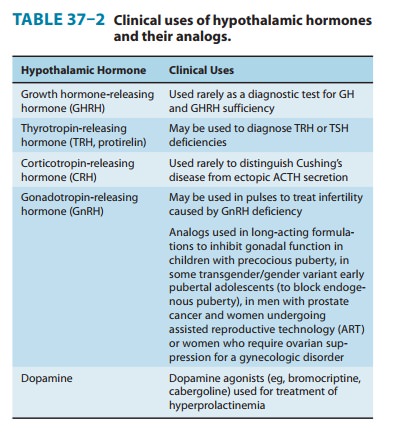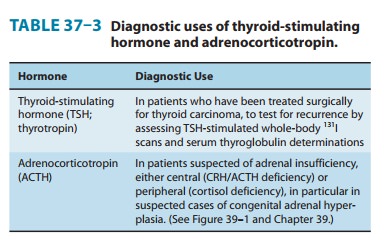Chapter: Basic & Clinical Pharmacology : Hypothalamic & Pituitary Hormones
Anterior Pituitary & Hypothalamic Hormone Receptors
ANTERIOR PITUITARY &
HYPOTHALAMIC HORMONE RECEPTORS
The anterior pituitary
hormones can be classified according to hormone structure and the types of
receptors that they activate. Growth
hormone (GH) and prolactin,
single-chain proteinhormones with significant homology, form one group. Both
hormones activate receptors of the JAK/STAT superfamily.
ACRONYMS
ACTH Adrenocorticotropic
hormone (corticotropin)
CRH Corticotropin-releasing
hormone
FSH Follicle-stimulating
hormone
GH Growth hormone
GHRH Growth
hormone-releasing hormone
GnRH Gonadotropin-releasing
hormone
hCG Human chorionic
gonadotropin
hMG Human
menopausal gonadotropin
IGF Insulin-like
growth factor
LH Luteinizing
hormone
PRL Prolactin
rhGH Recombinant
human growth hormone
SST Somatostatin
TRH Thyrotropin-releasing
hormone
TSH Thyroid-stimulating
hormone (thyrotropin)
Three pituitary hormones—thyroid-stimulatinghormone (TSH, thyrotropin), follicle-stimulating hormone (FSH), and luteinizing hormone (LH)—are dimeric proteinsthat activate G protein-coupled receptors . TSH, FSH, and LH share a common α chain. Their β chains, though somewhat similar to each other, differ enough to confer receptor specificity.
Finally, adrenocorticotropic hormone (ACTH), a
single peptide cleaved from a larger precursor that also contains the peptide β-endorphin ,
represents a third cat-egory. Like TSH, LH, and FSH, ACTH acts through a G
protein-coupled receptor. A unique feature of the ACTH receptor (also known as
the melanocortin 2 receptor) is that a transmembrane protein, melanocortin 2
receptor accessory protein, is essential for normal ACTH receptor trafficking
and signaling.

TSH, FSH, LH, and ACTH
share similarities in the regulation of their release from the pituitary. Each
is under the control of a distinctive hypothalamic peptide that stimulates
their production by acting on G protein-coupled receptors (Table 37–1). TSH
release is regulated by thyrotropin-releasing
hormone (TRH), whereas the release of LH and FSH (known collectively as
gonad-otropins) is stimulated by pulses of gonadotropin-releasinghormone
(GnRH). ACTH release is stimulated by
corticotro-pin-releasing hormone (CRH). An important regulatory
featureshared by these four structurally related hormones is that they and
their hypothalamic releasing factors are subject to feedback inhib-itory
regulation by the hormones whose production they control. TSH and TRH
production are inhibited by the two key thyroid hormones, thyroxine and
triiodothyronine . Gonadotropin and GnRH production is inhibited in women by
estrogen and progesterone, and in men by testosterone and other androgens. ACTH
and CRH production are inhibited by cortisol. Feedback regulation is critical
to the physiologic control of thy-roid, adrenal cortical, and gonadal function
and is also important in pharmacologic treatments that affect these systems.
The hypothalamic
hormonal control of GH and prolactin differs from the regulatory systems for
TSH, FSH, LH, and ACTH. The hypothalamus secretes two hormones that regulate
GH; growth hormone-releasing hormone
(GHRH) stimulates GH production, whereas the peptide somatostatin (SST) inhibits GH production. GH and its primary
peripheral mediator, insu-lin-like
growth factor-I (IGF-I), also provide feedback to inhibitGH release.
Prolactin production is inhibited by the catecholamine dopamine acting through the D2subtype of dopamine receptors.The hypothalamus
does not produce a hormone that specifically stimulates prolactin secretion,
although TRH can stimulateprolactin release, particularly when TRH
concentrations are high in the setting of primary hypothyroidism.

Whereas all the
pituitary and hypothalamic hormones described previously are available for use
in humans, only a few are of major clinical importance. Because of the greater
ease of administration of target endocrine gland hormones or their synthetic
analogs, the related hypothalamic and pituitary hormones (TRH, TSH, CRH, ACTH,
GHRH) are used infrequently as treatments. Some, such as ACTH, are used for
specialized diagnostic testing. These agents are described in Tables 37–2 and
37–3. In contrast, GH, SST, LH, FSH, GnRH, and dopamine or analogs of these
hormones are commonly used and are described in the following text.

Related Topics